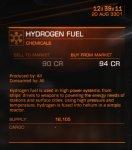I'm not sure right now.
How about allowing any ship of any size to attempt a landing - make the danger and risk of ship destruction for large ships increase dependent on the specific conditions of the planet.
I'm not sure right now.
How about allowing any ship of any size to attempt a landing - make the danger and risk of ship destruction for large ships increase dependent on the specific conditions of the planet.
Lol,
Input details: Gravity, atmosphere, thrust capacity, ship type, mass
Computer says No.....cough.
Am getting a little confused honestly, what is actually preventing ships from taking off 'slowly' from a planet? Other then impractical with our current technology? Given the power in the space ships, what prevents them from taking off/landing on planet in any way they want? even a planet with an atmosphere, as long as there is enough thrust to overcome gravity? and landing what prevents the ship from just slowing down match the planets rotation and then slowly descend? By my understanding, any speed can bring you off a planet, as long as you kan keep that speed up, as long as the ships are strong enough to beat gravity / resistance initially they can continue to rise upwards at whatever speed they want?
The reason we can't do that ourselves is limits of technology, not because physics don't allow it?
The question seems to be whether they have the power to take off in the first place. The t9 for instance has awful thrusters and due to its mass may not be able to take off in a 4g environment, being unable to generate enough thrust to counter gravity, or wind resistance perhaps in the case of atmosphere.
Just gimmie some wheels on my Clipper's landing gear and point me in the direction of the nearest runway .... Cheers
Can we have floats for water worlds too?
Bring back the Moray Starboat!Can we have floats for water worlds too?
Am getting a little confused honestly, what is actually preventing ships from taking off 'slowly' from a planet? Other then impractical with our current technology? Given the power in the space ships, what prevents them from taking off/landing on planet in any way they want? even a planet with an atmosphere, as long as there is enough thrust to overcome gravity? and landing what prevents the ship from just slowing down match the planets rotation and then slowly descend? By my understanding, any speed can bring you off a planet, as long as you kan keep that speed up, as long as the ships are strong enough to beat gravity / resistance initially they can continue to rise upwards at whatever speed they want?
The reason we can't do that ourselves is limits of technology, not because physics don't allow it?

You don't. The engines on the ships have a ridiculous t/w ratio and large amount of delta-v.
Ahem...... please allow me to clear this discussion up........
http://www.youtube.com/watch?v=_ARUcwKXIqQ
Almost all ships are able to accelerate at multiple G's in all axes. Only the largest (think type 9) would have issues on anything higher than 1g worlds. The rest could easily compensate against gravity, so much so we're actually trying to justify gimping their ability to compensate to add some additional finesse to flying in a strong gravity well for Horizons.
Obviously for EDH there's no atmosphere which gives two things 1) No lifting-body effect, and 2) no issues with thruster performance.Almost all ships are able to accelerate at multiple G's in all axes. Only the largest (think type 9) would have issues on anything higher than 1g worlds. The rest could easily compensate against gravity, so much so we're actually trying to justify gimping their ability to compensate to add some additional finesse to flying in a strong gravity well for Horizons.
